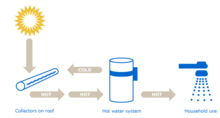Solar Water Heating System 6000Liter
This Project Is for a New Hotel in Bannergatta, Jigni, Bangalore
Solar water heating (SWH) is the conversion of sunlight into renewable energy for water heating using a solar thermal collector. Solar water heating systems comprise various technologies that are used worldwide increasingly.
In a "close-coupled" SWH system the storage tank is horizontally mounted immediately above the solar collectors on the roof. No pumping is required as the hot water naturally rises into the tank through thermosiphon flow. In a "pump-circulated" system the storage tank is ground- or floor-mounted and is below the level of the collectors; a circulating pump moves water or heat transfer fluid between the tank and the collectors.
SWH systems are designed to deliver hot water for most of the year. However, in winter there sometimes may not be enough solar heat gain to deliver sufficient hot water. In this case a gas or electric booster is used to heat the water.
Overview
Water heated by the sun may be used in various ways. While perhaps best known in a residential setting to provide domestic hot water, solar hot water also has industrial applications (e.g. to generate electricity).[1] Designs suitable for hot climates can be much simpler and cheaper, and can be considered an appropriate technology for these places. The global solar thermal market is dominated by China, Europe, Japan and India.
In order to heat water using solar energy, a collector, often fastened to a roof or a wall facing the sun, heats a working fluid that is either pumped (active system) or driven by natural convection (passive system) through it.[2] The collector could be made of a simple glass-topped insulated box with a flat solar absorber made of sheet metal, attached to copper heat exchanger pipes and dark-colored, or a set of metal tubes surrounded by an evacuated (near vacuum) glass cylinder. In industrial cases a parabolic mirror can concentrate sunlight on the tube. Heat is stored in a hot water storage tank. The volume of this tank needs to be larger with solar heating systems in order to allow for bad weather[clarification needed], and because the optimum final temperature for the solar collector is lower than a typical immersion or combustion heater. The heat transfer fluid (HTF) for the absorber may be the hot water from the tank, but more commonly (at least in active systems) is a separate loop of fluid containing anti-freeze and a corrosion inhibitor which delivers heat to the tank through a heat exchanger (commonly a coil of copper heat exchanger tubing within the tank). Copper is an important component in solar thermal heating and cooling systems because of its high heat conductivity, resistance to atmospheric and water corrosion, sealing and joining by soldering, and mechanical strength. Copper is used both in receivers and primary circuits (pipes and heat exchangers for water tanks).[3]
Another lower-maintenance concept is the 'drain-back'. No anti-freeze is required; instead, all the piping is sloped to cause water to drain back to the tank. The tank is not pressurized and is open to atmospheric pressure. As soon as the pump shuts off, flow reverses and the pipes are empty before freezing could occur.
Residential solar thermal installations fall into two groups: passive (sometimes called "compact") and active (sometimes called "pumped") systems. Both typically include an auxiliary energy source (electric heating element or connection to a gas or fuel oil central heating system) which is activated when the water in the tank falls below a minimum temperature setting such as 55 °C. Hence, hot water is always available. The combination of solar water heating and using the back-up heat from a wood stove chimney to heat water[4] can enable a hot water system to work all year round in cooler climates, without the supplemental heat requirement of a solar water heating system being met with fossil fuels or electricity.
When a solar water heating and hot-water central heating system are used in conjunction, solar heat will either be concentrated in a pre-heating tank that feeds into the tank heated by the central heating, or the solar heat exchanger will replace the lower heating element and the upper element will remain in place to provide for any heating that solar cannot provide. However, the primary need for central heating is at night and in winter when solar gain is lower. Therefore, solar water heating for washing and bathing is often a better application than central heating because supply and demand are better matched. In many climates, a solar hot water system can provide up to 85% of domestic hot water energy. This can include domestic non-electric concentrating solar thermal systems. In many northern European countries, combined hot water and space heating systems (solar combisystems) are used to provide 15 to 25% of home heating energy. When combined with storage, large scale solar heating can provide 50-97% of annual heat consumption for district heating.
PT 100 temperature sensor




























No comments:
Post a Comment